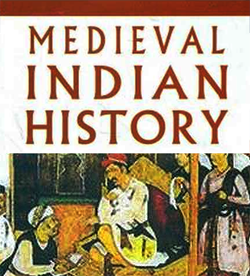(Medieval Indian History) The Tripartite Struggle: 8th to 10th Centuries
EARLY MEDIEVAL INDIA (800 - 1200 AD)
The Tripartite Struggle: 8th to 10th Centuries
Between 750 AD and 1000 AD three empires dominated the political scene in India. These were the Palas who dominated eastern India till the middle of the 9th century; the Pratiharas who dominated the western part of India and the upper gangetic valley till the middle of the 10th century, and the Rashkrakuta empire, which dominated the deccan and also controlled the territory in north and south India at various times. They were involved in conflict among themselves, but provided stable conditions of life over large areas and gave patronage to arts and letters of the three, the rashtrakuta empire lasted the longest, it was also the most powerful empire of the three and acted as a bridge between north and south India in economic as well as cultural matters.
Palas: Ruled in areas of Bihar and Bengal with capital at Mongyr (Munger).
Gopala: The death of Sasanka of Gauda created anarchy and confusion in Bengal, whereupon the notable men of Bengal elected Gopala as King in 750 AD. Gopala thus set up the pala Kingdom. Gopala was an ardent Buddhist and set up the Odantapuri Vihar (modem Bihar Sharif).
Dharmpala: Gopala was succeeded by his son Dharampala. Dharampala was defeated by the Rashktrakuta ruler Dhruva –III who also defected the Pratihara ruler vatasraja. But, Dhruva returned to the Deccan were upon Dharampala accupied Kannauj but could not consolidate his control over it as Pratihara power revived under Nagabhata II who defeted Dharampala near Mongyr.
Devapala: The son of Daharmpala succeeded him. He extended control over Prayag jyotispur (Assam) and also part of Orissa and probably during his reign, some part of Vihara at Nalanda was constructed by Balaputradev, a Sailendera ruler of Sumitra, Java and Malaya.
Pratiharas: The Pratiharas are also called Gurjara- Pratiharas. They were settled at Bhinmal in Rajputana. The word Pratiharas literally means the door-keepar.
Nagabhatta I: He resisted the Arab invasions and acquired fame.
Vatsaraja: Attempted to capture Malwa but was defeated by the Rashtrakuta ruler Dhurva III.
Nagabhatta II: He was a great conqueror. He defeated Dharmapala and captured Kannauj but was defeated by the Rashtrakuta King Govind III. But Govind III Returned to the Deccan and so Nagabhatta II again captured Kannauj. Nagabhatta II also came into conflict with devapala.
Mihirbhoja (836-885AD): Considerd the greatest ruler of Pratiharas. Arab travelers tell us that the Pratiharas had the best cavalry in india. They acquired horses from central Asia and Arabia as an import item of trade. Bhoja used his horses well in military conquests. He tried to extend his sway in the east but was defeated by the pala ruler Devpala.
Mahendrapala: Bhoja was succeeded by his son Mahendrapala I. He extended the empire into Magadha and North Bengal. His inscription have also been found from east Punjab, Awadh and Kathiawar. He fought a battle with the king of Kashmir but had to yield to him some of the territories in the Punjab won by Bhoja.
Mahipala: Succeeded Mahendrapala I. He patronzed the poet Rajashekhar who wrote Karpuramanjari, Kavyamiansa. Balaramayana and Bala and Bharata.
Rashtrakutas
The Rashtrakutas Originally belonged to Lattalura, modern Latur of Maharashtra. They were of Kannada origin and Kannada was their mother tongue.
Dantidurga: He was the founder of the Rashtrakutas. He fixed his capital at Manyakhet or Malkhed near modern Sholapur. He began his as a feudatory of Chalukyas of Kalyani . His victories are mentioned in Samangad plates and Dasavatara cave the stronghold of Chalukyas of Kalyani .
Krishna I: Dnatidurga died childless and was followed by his uncle Krishna I. He constructed the magnificent rock – cut monolithic temple at Ellora, now known as Kailasanath temple at Ellora.
Dhruva III: He was the next important ruler. He defeated the Pratihara ruler Vatsaraja and also the Pala ruler Dharmapala.
Govind III: He defeated the Pratihara ruler Nagabhatta II and the Pala ruler Dharmapala . He was succeeded by Amoghavarsha I.
Amoghavarsha I(814 – 78 AD): He was the greatest Rashtrakuta King. He preferred religion and literature to war. He was called as ‘Sarva’ and also as ‘Nripatunga’ . Amoghavarsha wrote the book Kavirajamarga which is the first work on poetics in Canarese (Kannada) He also authored a book called Ranamalika and another called Passanotaramalika based on moral principles.
Indria III: He was the next important ruler. He re-established the empire. He was the most powerful ruler of his times. In 915 AD, he invaded Kannauj and gained control of Gujrat.
Krishna III: He was the next important ruler. In 963 AD, He invaded north India and defeated the Pratihara ruler. He also defeated the Chola ruler Parantaka I in 949 AD and annexed the northem part of Chola empire. He then pressed into Rameswaram and set up a pillar of victory there and built a temple.
data-matched-content-ui-type="image_card_stacked"
Useful Tips & Articles
तैयारी कैसे करें? |
EXAM SUBJECTS |
STUDY RESOURCESDownload Free eBooks |



